How it all began
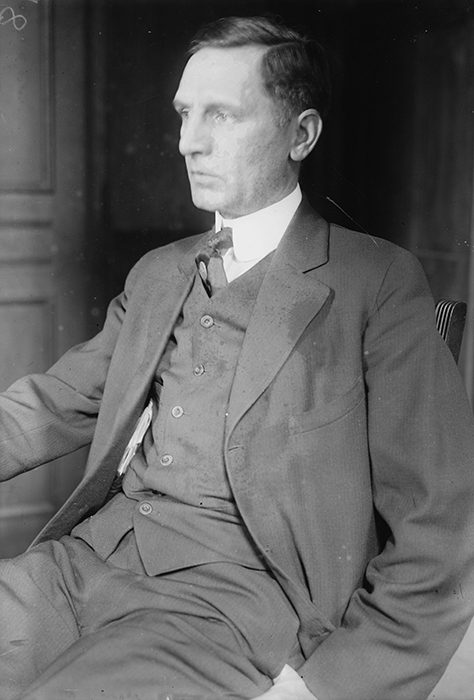
Image: Library of Congress LC-B2-3621-11
On January 3, 1920, a cheeky letter from Walter J. Kingsley titled “‘Jurgen’ and the Non-Reading Public” appeared in the New York Tribune. Kingsley wrote, “James Branch Cabell is making a clean getaway with “Jurgen,” quite the naughtiest book since George Moore began ogling maidservants in Mayo.” A copy of the Tribune made its way to John. S. Sumner, head of the New York Society for the Suppression of Vice.
The NYSSV was an organization founded by Anthony Comstock in 1873 to fight materials and conduct that it perceived as immoral or obscene. Later that year, Comstock successfully lobbied the United States Congress to pass the Comstock Law, which made illegal the delivery by U.S. mail, or by other modes of transportation, of “obscene, lewd, or lascivious” material, as well as prohibiting any methods of production or publication of information pertaining to the procurement of abortion, the prevention of conception and the prevention of venereal disease. The Act also criminalized personal letters with any sexual content or information.
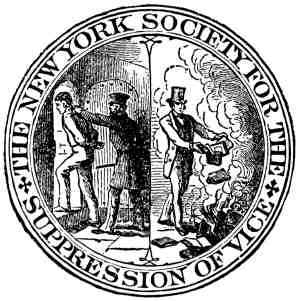
Image: Public domain
Though it was not a government agency, the NYSSV gained power when the New York state legislature granted NYSSV agents powers of search, seizure and arrest in the policing of morality. John Saxton Sumner succeeded Comstock as executive secretary of the NYSSV in 1915, vowing to do even more than Comstock to suppress “smut.” Under Sumner’s leadership, the NYSSV focused especially on literature, including Theodore Dreiser’s The Genius, James Joyce’s Ulysses and James Branch Cabell’s Jurgen: A Comedy of Justice.
Walter J. Kingsley, The New York Tribune, January 3, 1920
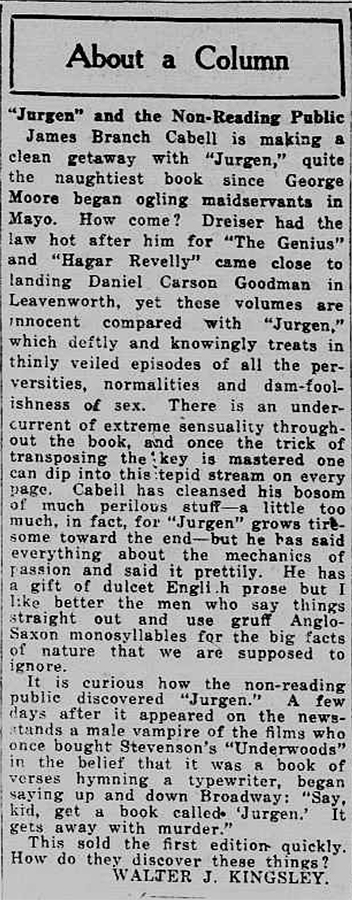
New York Tribune, Jan. 3, 1920
The following is a transcription of the New York Tribune letter.
“Jurgen” and the Non-Reading Public
James Branch Cabell is making a clean getaway with “Jurgen,” quite the naughtiest book since George Moore began ogling maidservants in Mayo. How come? Dreiser had the law hot after him for “The Genius” and “Hagar Revelly” came close to landing Daniel Carson Goodman in Leavenworth, yet these volumes are innocent compared with “Jurgen,” which deftly and knowingly treats in thinly veiled episodes of all the perversities, normalities and dam-foolishness of sex. There is an under-current of extreme sensuality throughout the book, and once the trick of transposing the key is mastered one can dip into this tepid stream on every page. Cabell has cleansed his bosom of much perilous stuff—a little too much, in fact, for “Jurgen” grows tiresome toward the end–but he has said everything about the mechanics of passion and said it prettily. He has a gift of dulcet English prose but I like better the men who say things straight out and use gruff Anglo-Saxon monosyllables for the big facts of nature that we are supposed to ignore.
It is curious how the non-reading public discovered “Jurgen.” A few days after it appeared on the newsstands a male vampire of the films who once bought Stevenson’s “Underwoods” in the belief that it was a book of verses hymning a typewriter, began saying up and down Broadway: “Say, kid, get a book called ‘Jurgen.” It gets away with murder.”
This sold the first edition quickly. How do they discover these things?
WALTER J. KINGSLEY.
Seizure and Legal Action
On January 14, 1920, members of the New York Society for the Suppression of Vice moved against Cabell’s publisher, Robert M. McBride. This telegram was sent to Cabell after midnight, arriving January 15, 1920.
Guy Holt, Cabell’s editor, was also charged and issued the summons below, which was preserved by James Branch Cabell. These two documents are now held in VCU Libraries Special Collections and Archives.
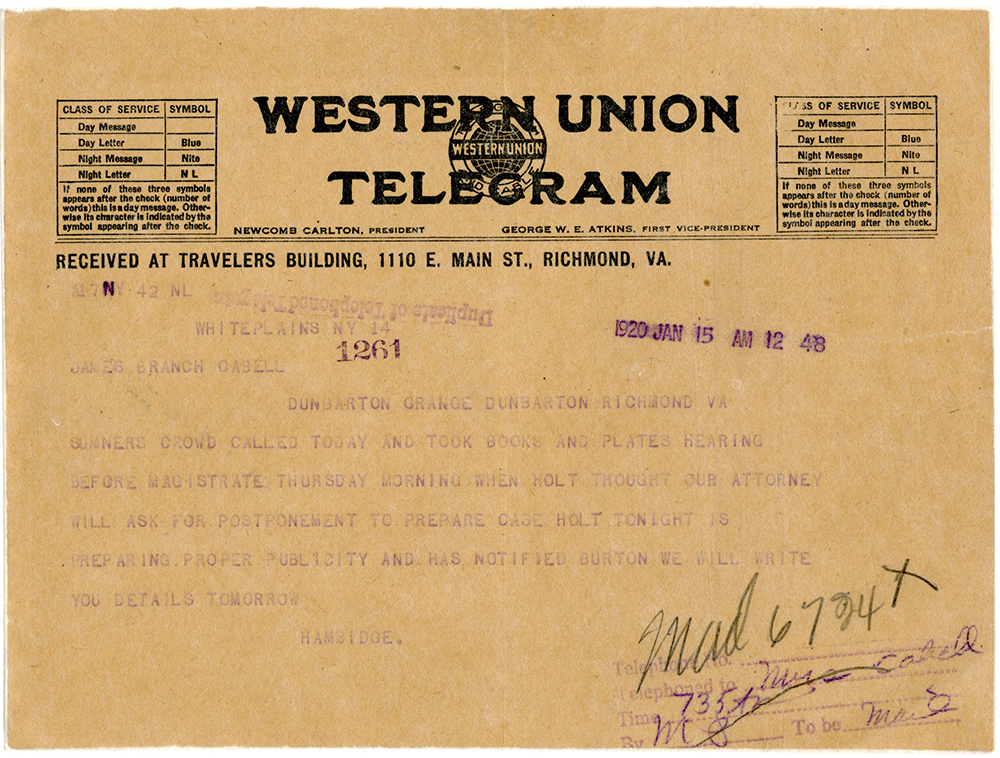
Special Collections and Archives, VCU Libraries
WHITE PLAINS NY 14
JAMES BRANCH CABELL
DUNBARTON GRANGE DUNBARTON RICHMOND VA [sic]
SUMNER CROWD CALLED TODAY AND TOOK BOOKS AND PLATES HEARING BEFORE MAGISTRATE THURSDAY MORNING WHEN HOLT THOUGHT OUR ATTORNEY WILL ASK FOR POSTPONEMENT TO PREPARE CASE. HOLT TONIGHT IS PREPARING PROPER PUBLICITY AND HAS NOTIFIED BURTON WE WILL WRITE YOU DETAILS TOMORROW
HAMBIDGE,
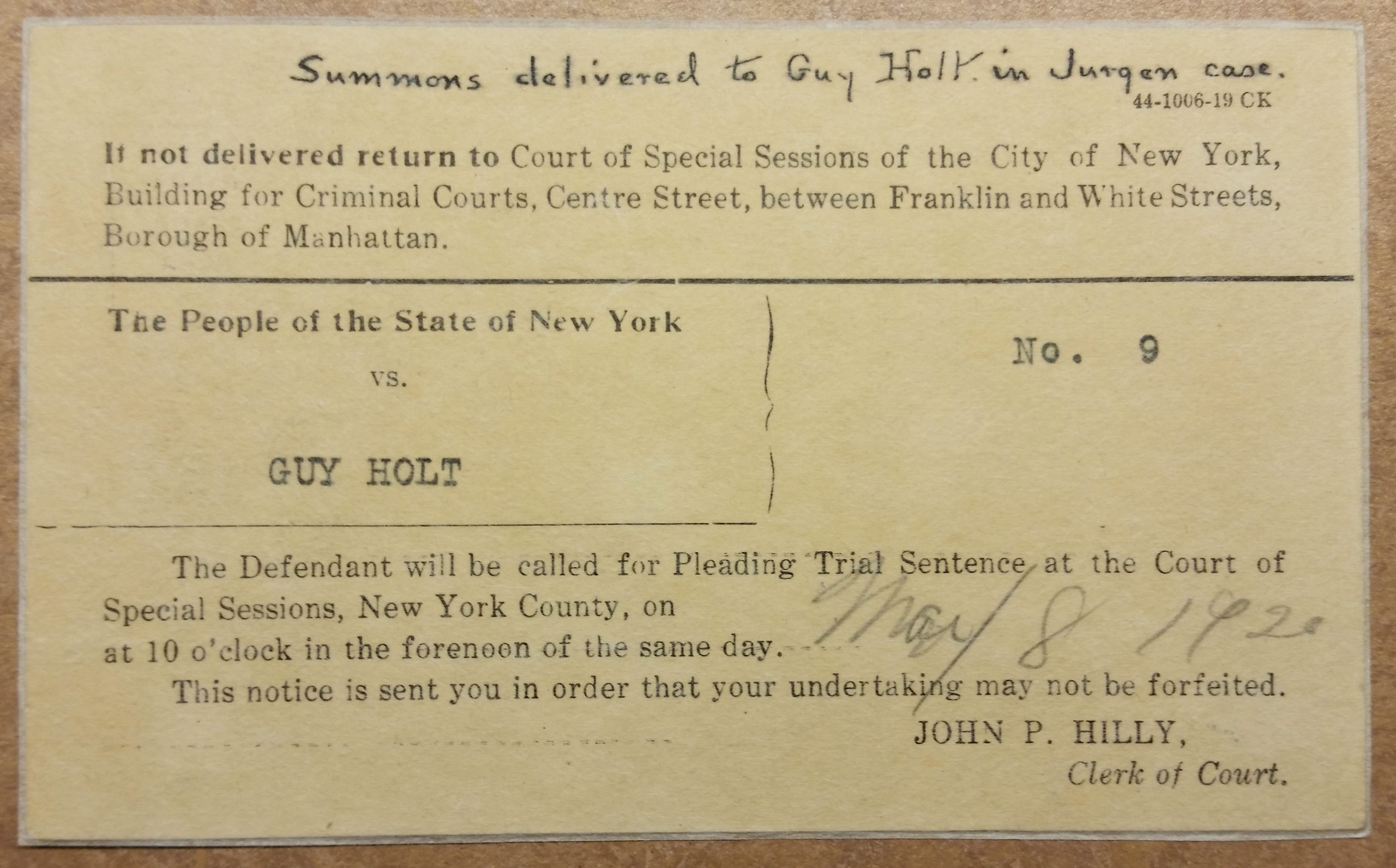
Special Collections and Archives, VCU Libraries
If not delivered return to Court of Special Sessions of the City of New York, Building for Criminal Courts, Centre Street, between Franklin and White Streets, Borough of Manhattan.
The People of the State of New York vs. GUY HOLT No. 9
The Defendant will be called for Pleading Trial Sentence at the Court of Special Sessions, New York County, on May 8 1920 at 10 o’clock in the forenoon of the same day.
This notice is sent you in order that your undertaking may not be forfeited.
JOHN P. HILLY,
Clerk of Court.
PREVIOUS: Banning Jurgen
Jurgen and the New York Society for the Suppression of Vice
NEXT: The Judging of Jurgen by James Branch Cabell (1920)